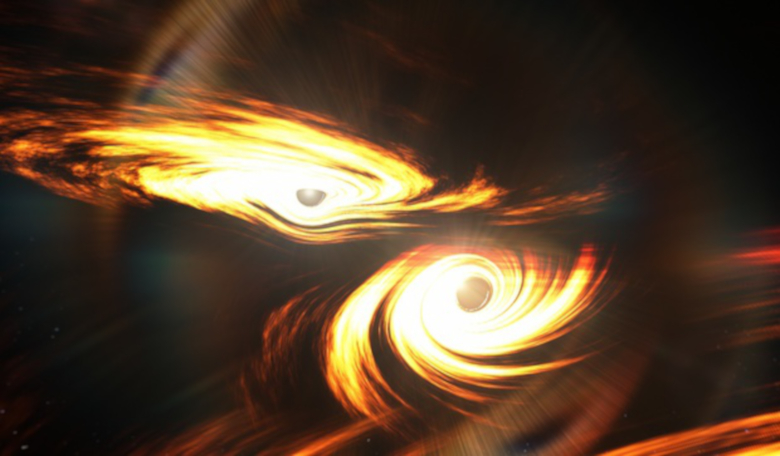Gravitational waves from what could be the most massive black hole merger yet has been detected by researchers at the Laser Interferometer Gravitational-wave Observatory (LIGO) and its discovery is also raising questions about how massive black holes are formed.
When scientists made the first direct detection of gravitational waves from a binary black hole merger in February 2016, not only did they prove Einstein right, they also discovered another curious quirk; the audible sound the waves made as the two bodies merged was an unmistakeable ‘chirp’ sound.
Providing the waves, and also the chirps, were two black holes that were ~36 and ~29 times more massive than our Sun.
Since then a number of other gravitational wave sources have been found, but all of the black holes in question have been within the parameters expected by scientists.
But LIGO’s most recent discovery, which has been labeled GW190521, stands out from the crowd.
Not only is the signal the most distant, and therefore the oldest ever detected (the event took place when the universe was about half its age now), the waves also didn’t particularly ‘chirp’ so much when detected but instead were much noisier.
“This doesn’t look much like a chirp, which is what we typically detect,” says Virgo member Nelson Christensen, a researcher at the French National Centre for Scientific Research (CNRS), comparing the signal to LIGO’s first detection of gravitational waves in 2015.
“This is more like something that goes ‘bang,’ and it’s the most massive signal LIGO and Virgo have seen.”
The bang signalling the sound of a merger belongs to two inspiralling goliaths with masses about 85 and 66 times the mass of the sun; and one those masses don’t tally with our current understanding of stellar processes.
All of the black holes observed to date fit within either of two categories: supermassive black holes, and stellar-mass black holes.
The first variety, such as the one at the center of the Milky Way galaxy, can be hundreds of thousands, to billions of times more massive than our sun and are thought to form through episodes of rapid gas accretion, though no-one really knows for sure.
The second type, stellar-mass black holes, measure from a few solar masses up to tens of solar masses and are thought to form when massive stars die, but it must be within a certain mass range to do so.
Stars as massive as 130 solar masses can produce black holes that are up to 65 solar masses. Conversely, massive stars above 200 solar masses would eventually collapse directly into a black hole of at least 120 solar masses.
But, in between that mass range, a phenomenon known as "pair instability” causes a star to become unstable against gravitational collapse and the resulting explosion is strong enough to leave nothing behind - not even a black hole.
This range is known as the "pair instability mass gap" and at 85 times the mass of our sun, the heaviest member of GW190521 is the first so far detected within this gap.
"The mass of the larger black hole in the pair puts it into the range where it's unexpected from regular astrophysics processes," said Peter Shawhan, a professor of physics at UMD, an LSC principal investigator and the LSC observational science coordinator. "It seems too massive to have been formed from a collapsed star, which is where black holes generally come from."
The team behind the discovery suggest that the larger object may have been the result of a previous black hole merger rather than a single collapsing star. This type of hierarchical combining of black holes has been hypothesised before but GW190521 would be the first evidence for such activity.
"Right from the beginning, this signal, which is only a tenth of a second long, challenged us in identifying its origin," said Alessandra Buonanno, a College Park professor at UMD and an LSC principal investigator.
While the team work out where this misfit massive black hole came from, GW190521 also ticks another first in black hole discoveries.
With the release of an enormous amount of energy equivalent to around 8 solar masses, the final 142-solar-mass black hole produced by the GW190521 merger lies within an intermediate mass range between stellar-mass and supermassive black holes.
Along with rapid gas accretion, intermediate-mass black holes have been linked to the formation of supermassive black holes, though so far their existence has only been hinted at by indirect evidence.
Now, with a bonafide detection, GW190521 is the first of its kind ever detected.
"LIGO once again surprises us not just with the detection of black holes in sizes that are difficult to explain, but doing it using techniques that were not designed specifically for stellar mergers," says Pedro Marronetti, program director for gravitational physics at the National Science Foundation.
"This is of tremendous importance since it showcases the instrument's ability to detect signals from completely unforeseen astrophysical events. LIGO shows that it can also observe the unexpected."











